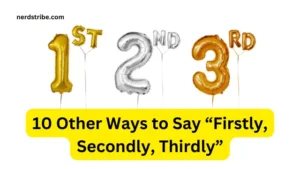Have you ever felt stuck in a loop, using the same phrase repeatedly while trying to express contrasting ideas? “On the other hand” is a common phrase that bridges two opposing thoughts or perspectives. While it serves its purpose well, overusing it can make your communication sound repetitive or uninspired.
Exploring alternatives is more than just expanding your vocabulary; it’s about finding ways to add creativity and clarity to your conversations and writing. Whether you’re crafting a persuasive argument, explaining a dilemma, or simply sharing different viewpoints, having a range of expressions can keep your message engaging and fresh.
In this blog, we’ll delve into 10 versatile alternatives to “on the other hand”. Each option will offer a unique tone and context, helping you choose the right words to suit your needs. Let’s explore these options and discover how they can transform the way you communicate.

Contents
1. “However”
A simple yet formal way to introduce contrast.
- Key Meaning: Suggests a contradiction or opposing view.
- Usage: Academic writing, professional emails.
- Example: “The proposal has potential; however, it requires further refinement.”
- Why It’s Effective: It’s concise and widely accepted in formal contexts.
2. “In Contrast”
A direct and precise phrase for comparison.
- Key Meaning: Highlights differences between two ideas.
- Usage: Essays, analytical reports.
- Example: “The first option is cost-effective. In contrast, the second offers better quality.”
- Why It’s Effective: It emphasizes distinctions clearly and professionally.
3. “Conversely”
A sophisticated term for contrasting ideas.
- Key Meaning: Suggests an opposing or reverse perspective.
- Usage: Academic discussions, formal presentations.
- Example: “He enjoys city life. Conversely, his brother prefers the countryside.”
- Why It’s Effective: It adds an intellectual tone to your arguments.
4. “That Said”
A casual yet impactful alternative.
- Key Meaning: Acknowledges the previous point while introducing a contrasting one.
- Usage: Informal conversations, blogs.
- Example: “The design is innovative. That said, it’s not very user-friendly.”
- Why It’s Effective: It’s conversational and relatable.
5. “Meanwhile”
A time-based yet effective contrast tool.
- Key Meaning: Highlights simultaneous but differing actions or ideas.
- Usage: Storytelling, news articles.
- Example: “She was preparing the report. Meanwhile, he was finalizing the budget.”
- Why It’s Effective: It ties actions and contrasts seamlessly.

6. “Yet”
A sharp and concise contrasting word.
- Key Meaning: Indicates an unexpected contradiction.
- Usage: Formal and informal contexts.
- Example: “The idea seemed feasible, yet it lacked proper execution.”
- Why It’s Effective: It’s short, impactful, and easy to integrate.
7. “Nevertheless”
A polished phrase for adding contrast.
- Key Meaning: Shows persistence or continuity despite challenges.
- Usage: Business communications, persuasive writing.
- Example: “The task was daunting. Nevertheless, the team delivered excellent results.”
- Why It’s Effective: It conveys determination and professionalism.
8. “On the Flip Side”
A casual and modern alternative.
- Key Meaning: Presents the other side of an argument.
- Usage: Informal conversations, social media posts.
- Example: “The movie was slow-paced. On the flip side, the acting was phenomenal.”
- Why It’s Effective: It’s fresh, friendly, and easy to use.
9. “Although”
A versatile option for contrast.
- Key Meaning: Implies opposition while maintaining the flow.
- Usage: Formal or casual contexts.
- Example: “Although the journey was long, it was worth every moment.”
- Why It’s Effective: It fits smoothly into most types of writing and speech.
10. “Alternatively”
An organized way to suggest another perspective.
- Key Meaning: Offers an alternative idea or approach.
- Usage: Professional settings, problem-solving discussions.
- Example: “We could stick to the original plan. Alternatively, we could explore new options.”
- Why It’s Effective: It’s clear, structured, and suggests choice.
Conclusion
In communication, variety is key. While “on the other hand” is a reliable phrase, overusing it can make your ideas feel monotonous. By incorporating these 10 alternatives, you can add freshness, precision, and creativity to your speech or writing. Whether it’s the simplicity of “yet” or the sophistication of “conversely,” each option offers a unique tone and context.
Mastering these phrases not only enhances your language skills but also helps you convey ideas more effectively. Next time you find yourself using “on the other hand,” challenge yourself to try one of these alternatives. Your audience will appreciate the effort, and your communication will shine with clarity and depth.
FAQs
Why should I avoid overusing “on the other hand”?
Overusing it can make your communication sound repetitive and less engaging.
Can I use these alternatives in formal writing?
Yes, many options like “however,” “nevertheless,” and “alternatively” are perfect for formal contexts.
Which alternative is best for casual conversations?
“That said” and “on the flip side” work well for informal settings.
How can I choose the right alternative?
Consider the tone, audience, and context of your communication.
Are these alternatives interchangeable?
Mostly, but nuances in tone and formality should guide your choice.
Do these phrases improve communication?
Absolutely! They add variety, clarity, and professionalism to your language.








